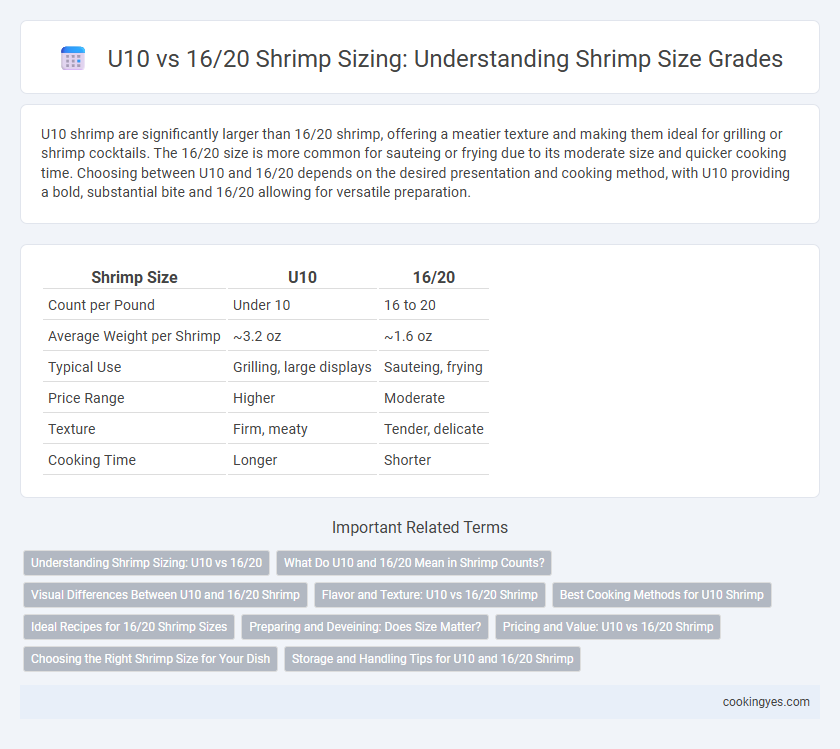U10 shrimp are significantly larger than 16/20 shrimp, offering a meatier texture and making them ideal for grilling or shrimp cocktails. The 16/20 size is more common for sauteing or frying due to its moderate size and quicker cooking time. Choosing between U10 and 16/20 depends on the desired presentation and cooking method, with U10 providing a bold, substantial bite and 16/20 allowing for versatile preparation.
Table of Comparison
| Shrimp Size | U10 | 16/20 |
|---|---|---|
| Count per Pound | Under 10 | 16 to 20 |
| Average Weight per Shrimp | ~3.2 oz | ~1.6 oz |
| Typical Use | Grilling, large displays | Sauteing, frying |
| Price Range | Higher | Moderate |
| Texture | Firm, meaty | Tender, delicate |
| Cooking Time | Longer | Shorter |
Understanding Shrimp Sizing: U10 vs 16/20
Shrimp sizing such as U10 and 16/20 refers to the number of shrimp per pound, where U10 indicates fewer than 10 shrimp per pound, representing larger shrimp ideal for grilling or main dishes. The 16/20 size range means there are between 16 and 20 shrimp per pound, offering a medium size suitable for versatile cooking methods like sauteing or frying. Understanding these size distinctions helps chefs and buyers select the perfect shrimp size for texture, cooking time, and presentation.
What Do U10 and 16/20 Mean in Shrimp Counts?
U10 and 16/20 refer to shrimp count per pound, indicating the size and quantity of shrimp in a pound. U10 means "under 10" shrimp per pound, representing very large shrimp often used for grilling or special dishes. The 16/20 count means there are 16 to 20 shrimp per pound, which are medium-large in size and commonly preferred for recipes requiring a balance of portion size and cooking time.
Visual Differences Between U10 and 16/20 Shrimp
U10 shrimp are significantly larger and meatier compared to 16/20 shrimp, typically exceeding 10 pieces per pound, while 16/20 shrimp range between 16 to 20 pieces per pound. Visually, U10 shrimp have a noticeably thicker tail and a more robust body, offering a substantial bite size that appeals to gourmet dishes. The 16/20 shrimp, being smaller, display a slimmer profile with a more delicate texture, making them ideal for recipes requiring quicker cooking times and a milder presentation.
Flavor and Texture: U10 vs 16/20 Shrimp
U10 shrimp, larger and less processed, offer a firmer texture and a richer, more succulent flavor profile compared to 16/20 shrimp, which are smaller and often used in dishes requiring quicker cooking. The meat of U10 shrimp holds up better in grilling and frying, delivering a more satisfying bite with a pronounced sweetness. In contrast, 16/20 shrimp provide a tender texture ideal for soups and salads but lack the depth of flavor found in the jumbo-sized U10.
Best Cooking Methods for U10 Shrimp
U10 shrimp, also known as jumbo shrimp, are ideal for grilling and frying due to their large size and firm texture, which holds up well to high heat cooking methods. Compared to 16/20 shrimp, U10 offers a meatier bite, making them perfect for recipes like shrimp skewers or crispy fried shrimp where size enhances presentation and flavor. Their substantial size also allows for stuffing or use in hearty seafood dishes without overcooking.
Ideal Recipes for 16/20 Shrimp Sizes
16/20 shrimp, often labeled as "jumbo," are ideal for recipes requiring even cooking and presentation such as shrimp scampi and grilled shrimp skewers. Their size allows for better retention of moisture and flavor when sauteed or baked, making them perfect for dishes like shrimp Alfredo and shrimp cocktails. These shrimp sizes pair well with robust seasonings and are versatile enough for both simple and complex recipes.
Preparing and Deveining: Does Size Matter?
U10 shrimp, being larger and meatier, require more time and careful handling during preparing and deveining to ensure thorough cleaning and ease of shell removal. In contrast, 16/20 shrimp, smaller in size, are quicker to devein but demand precision to avoid breaking the delicate flesh. Selecting the appropriate size depends on the recipe and cooking method, as larger shrimp yield more substantial portions while smaller sizes facilitate faster prep and uniform cooking.
Pricing and Value: U10 vs 16/20 Shrimp
U10 shrimp, larger than 16/20 count, typically command higher prices due to their size and meat yield, offering better value for recipes requiring substantial shrimp presence. The 16/20 shrimp, moderately priced, provide a balance between affordability and portion size, making them popular for versatile cooking options. Choosing between U10 and 16/20 shrimp hinges on budget and intended dish presentation, with U10 favored for premium appeal and 16/20 for cost-effective versatility.
Choosing the Right Shrimp Size for Your Dish
Selecting the right shrimp size, such as U10 or 16/20, depends on cooking method and recipe requirements, where U10 indicates extra large shrimp with fewer than 10 pieces per pound ideal for grilling or shrimp cocktails, while 16/20 means medium-large shrimp with 16 to 20 per pound suited for sauteing or stir-fries. Size influences texture, cooking time, and presentation, with larger shrimp providing a meatier bite and shorter cook times to avoid toughness. Understanding shrimp count per pound ensures portion control and optimal flavor balance for dishes.
Storage and Handling Tips for U10 and 16/20 Shrimp
U10 shrimp, being larger and more delicate, require careful handling to prevent damage during storage; keep them frozen at -18degC or lower and avoid frequent temperature fluctuations to maintain texture and flavor. For 16/20 shrimp, slightly smaller and firmer, store in airtight containers or vacuum-sealed bags to extend shelf life while minimizing exposure to air and moisture. Both sizes benefit from quick thawing in cold water rather than room temperature to ensure food safety and preserve quality.
U10 vs 16/20 for shrimp sizing Infographic

 cookingyes.com
cookingyes.com